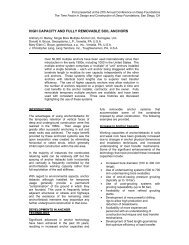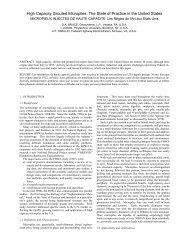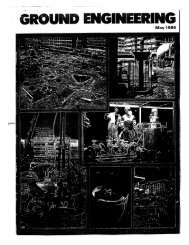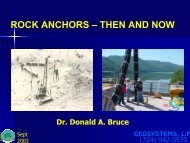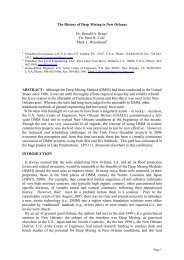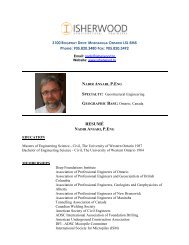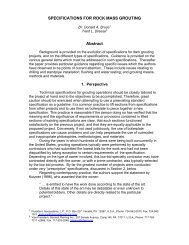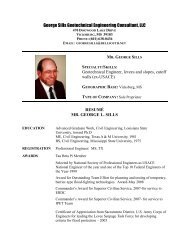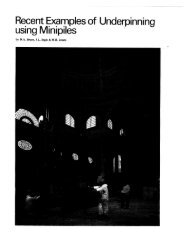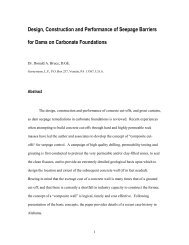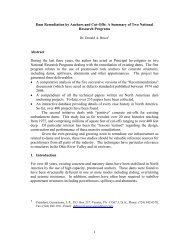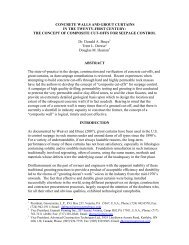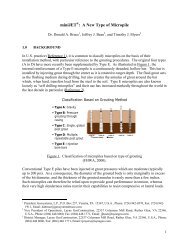SEEPAGE CUT-OFFS FOR LEVEES: A ... - Geosystems, L.P.
SEEPAGE CUT-OFFS FOR LEVEES: A ... - Geosystems, L.P.
SEEPAGE CUT-OFFS FOR LEVEES: A ... - Geosystems, L.P.
Create successful ePaper yourself
Turn your PDF publications into a flip-book with our unique Google optimized e-Paper software.
Overall Verdict<br />
“Conventional” DMM is a well researched and resourced technology which has been<br />
used in North America for over 20 years. Compared to more recent DMM variants, such<br />
as TRD and CSM, however, it is more sensitive to significant variability in the<br />
penetrability and composition of the ground, and the product tends to be less<br />
homogeneous. Like all DMM technologies, it has intrinsically a relatively high cost basis<br />
(due to the highly specialized large scale equipment) and so will not be competitive when<br />
lower technology systems (e.g., backhoe) can be used.<br />
TRD (Trench Re-Mixing and Cutting Deep Wall) Method<br />
Background<br />
This Japanese development was conceived in 1993, was tested for the first time in 1994<br />
and, up to mid-2003, had been used on over 220 projects, mostly after 1997. The TRD<br />
machine comprises a crawler mounted base, which provides continuous horizontal<br />
movement of a trench cutter, basically comprising a chain saw mounted on a long<br />
rectangular section “cutting post” (Photographs 2 and 3). Depending on the ground<br />
conditions and the model of TRD, walls from 18 to 34 inches thick can be installed to<br />
maximum depths of 170 feet.<br />
After the cutting post has been fully inserted into the bentonite filled starting hole, the<br />
cutting chain is activated and horizontal movement is imparted by the base machine.<br />
Throughout cutting, the desired cement-based grout is injected into the cut and so a<br />
soilcrete material is created in situ. The nature of the mixing and cutting assures a high<br />
degree of soilcrete homogeneity due to the vertical soil and grout movement generated by<br />
the chain. When the operation has to be “rested,” the cement-based grout is substituted<br />
by the bentonite slurry again (or it can be retarded) and so the cutting post can be safely<br />
“parked” in the trench without being cemented in. Upon resumption of cutting, this<br />
section is recut with the cement-based mix to assure the lateral continuity of the soilcement<br />
wall. Most of the Japanese applications to date have been for levee repair, and<br />
most have been to install vertical diaphragms, although substantial angles off vertical can<br />
be provided. In the U.S., Hayward Baker, Inc. have adopted the technology in the U.S.<br />
Following a demonstration program for the Bureau of Reclamation and the Water<br />
Replenishment District of Southern California at the Alamitos Gap, CA, in 2005,<br />
Hayward Baker, Inc. have successfully utilized the TRD method to construct several<br />
projects in Reach 1 of Herbert Hoover Dike, FL since 2008.<br />
Properties and Characteristics<br />
The grout mixes which are injected can be tailored to the specific project requirements.<br />
The properties of the wall will also reflect, of course, the nature of the virgin ground as<br />
the volume ratio is usually 35-50%. Unconfined compressive strengths of 100 to 3,000<br />
psi can be achieved, with a wide range of failure strains (0.5 to 3.0%). Permeabilities are<br />
typically in the range of 1x10 -6 to 1x10 -8 cm/s. There are no vertical or horizontal



